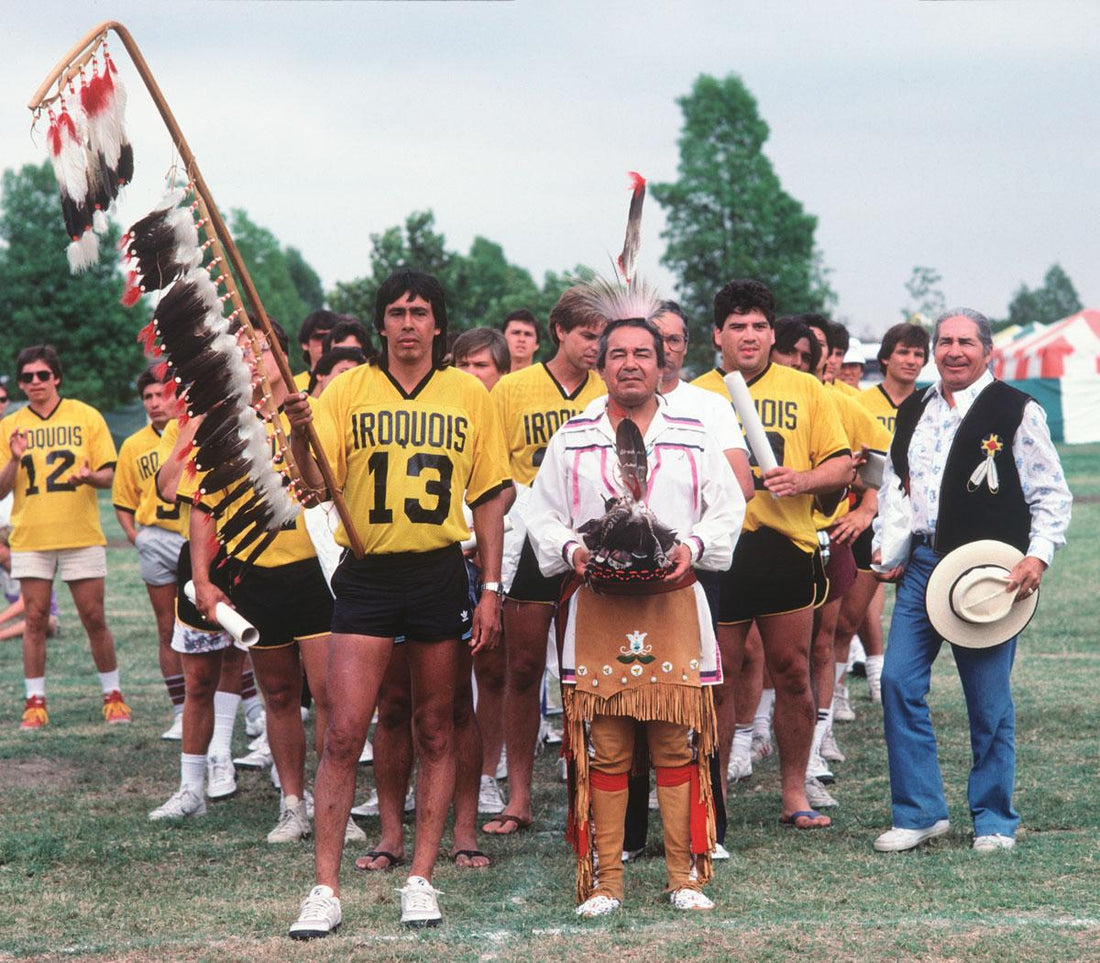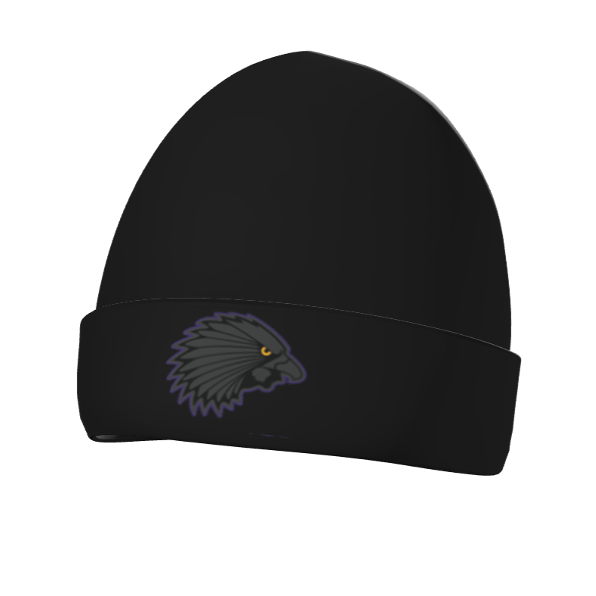In 1932, the sport of lacrosse was put on display for the world to see at the Olympic Games in Los Angeles. Canada and the United States played in a series of demonstration games in front of 75,000 spectators at the Los Angeles Memorial Coliseum.
Canada had a pair of teams flying under their flag during the process leading to the Summer Games. One of them was an All-Star team from Six Nations.
Fast forward nearly a century, and the Haudenosaunee Nationals are staring down an opportunity to fly their own flag and represent Indigenous peoples on the world stage at the 2028 Olympics, which will also be held in Los Angeles.
But the road to the Olympics has been a long one with many bumps and obstacles along the way. The journey started in 1983 when the Iroquois Nationals team was formed by a group featuring legendary Syracuse goaltender Oren Lyons, Richard Hill, and stick-maker Wes Patterson.
Oren’s son, Rex, played for the inaugural team and helped begin to pave the way for the then-Iroquois Nationals to make their debut globally.
“In its inception, they asked if they could really do this and what it was going to take. Because there would be political implications. Then, there were questions of, ‘What are we going to call it, and how will we get support from the Grand Council?’ All of those things had to be ironed out,” Rex Lyons said. “Once we got the ball rolling, we had to put the team together, which was a challenge in itself because we come from different territories. We had full schedules and day jobs and that kind of thing. So, it was a real challenge at the start.”
During the mid 80’s when the team was founded, there were only four member nations in World Lacrosse – the United States, Canada, Australia, and England. After seven years of working towards appearing in a major competition, the Iroquois Nationals played in the 1990 World Lacrosse Championships in Perth, Australia.
The Iroquois were now getting the chance to prove themselves against the other top teams from around the globe.
The team opted to fashion their flag with the Hiawatha Belt – the national belt of the Haudenosaunee peoples. It was used for the Nationals in 1990 and has become a symbol in Indigenous communities around the world.
Lyons recalled the moment the team stood on the field during the tournament’s opening ceremony, heard their anthem, and saw their flag fly for the first time.
“I can remember having goosebumps and going, ‘Wow, this is heavy.’ There the five nations were, and our flag was standing right next to theirs. And they all stood in silence and respect for our anthem and our flag,” Lyons said. “You had several world powers, including the United States, and we were there standing shoulder to shoulder and equal in that moment. As an athlete, you’re there to give your best, and you love to play the game. But at that moment, I got a glimpse of what was going on and how much bigger the moment was than just playing the game that I loved.
“...I got a glimpse of it, and everybody else did, too. We talked about having our ancestors standing right there beside us, and we said, ‘Look where lacrosse has taken us. It’s given us this platform to be gaining some of this ground.’ It was really a feel-good moment.”
That tournament was the first stepping stone for the team to build towards something special. While already being a medal-round staple in box, the team earned its first bronze medal in field during the 2014 World Lacrosse Championships in Denver. They followed that up with another bronze during the 2018 World Championships in Netanya, Israel.
“There is a real cultural shift within the Nationals where you talk to the players now and they have an understanding of the big picture. It was so new when I started, and we were just playing another version of the game. But it was also about bringing the confederacy together in a way that we had never been before,” Lyons said. “Now, there’s this evolution where we have some of the best players in the world, and they’re great ambassadors who our young people really look up to. Before, we had a tough time getting players to buy in. But now, (the players) travel around, you’re winning medals in the Worlds, and you’re potentially going to be Olympians.
“We’re still here after everything we’ve had to weather, and we’re still doing it with dignity and grace.”
In 2022, the decision was made for the name of the team to be changed to the Haudenosaunee Nationals officially. Lyons added that Iroquois is a name the French called Indigenous peoples, and it’s a derogatory term that translated to snakes.
“Because of our history, we said, ‘We’ve got to fix this. If we’re going to do this, we’ve got to do it all the way and details like that, you just can’t take for granted,” Lyons said. “We’ve always been the Haudenosaunee, and the Haudenosaunee means ‘People of the Longhouse.’”
The last few years have been busy for the Haudenosaunee Nationals and its staff. With the 2022 World Games and 2022 World U-21 Lacrosse Championships taking place last summer and the World Lacrosse Championships on the horizon this year, it’s given Lyons and the rest of the organization a chance to best prepare for the workload it will take to reach the Olympics.
In June, the World will converge in San Diego for the World Lacrosse Championships, where the Haudenosaunee Nationals will be looking to medal for the third consecutive tournament.
Lyons just recently returned from a trip to San Diego. While he was there to figure out logistics for the Haudenosaunee Nationals, he was also able to connect with tribal communities in California, which will allow for new opportunities for education and inclusion during the World Lacrosse Championships and beyond.
“We’re not only trying to educate the world, but we’re trying to bring our Brother and Sister nations together to support, rally, and get them involved in this. Because at the end of the day, I see the Nationals leading the way for athletes in other disciplines, but it’s a very complicated landscape,” Lyons said. “There are over 576 different tribal nations in the US and 630 in Canada, and a lot of people don’t know this fact. There are different languages, different ceremonies, different territories, and different politics. That’s how complex it is.
“I found out just from going to San Diego, that there are four different tribal bands within the county. So you have to get familiar with the lay of the land, who are the leaders, and really do some legwork, which is what we do.”
Following the conclusion of the World Lacrosse Championships, the Haudenosaunee Nationals have International events every year before 2028 rolls around.
There are still hurdles to overcome before the Haudenosaunee makes it to the Olympic Games. Lyons mentioned that in order to be recognized, the Nationals would need to have athletes in five different disciplines – something that is attainable with all the different athletes that are in our indigenous communities.
When the Haudenosaunee Nationals take to the field for the World Championships this summer, they’ll be doing it for more than the game. They’ll be playing for their ancestors, families, their communities, and their nations just like the first time they took the field in a major International competition in 1990.
And in a few short years, they’ll have the chance to make history and appear in the Olympics for the first time.
“The one thing about the Haudenosaunee Nationals is that we’re the underdogs. People really like to cheer for us because we’ve overcome so many challenges to be top three in the world. It’s a pretty astounding feat considering the lopsided nature of the population,” Lyons said. “Why is this the fastest-growing sport in the world? Because of the origins to the Medicine Game – and the world needs some serious medicine right now, whether they realize it or not.
“...Being such a small nation and being able to stay afloat in such a competitive and volatile environment, it’ll swallow you up if you don’t have the wherewithal to manage it. It’s our spiritual strength and our spiritual fortitude that has always helped us to survive. Going to the Olympics would just be a win-win. This is going to be good for the Olympics; this is going to be good for the IOC.”




